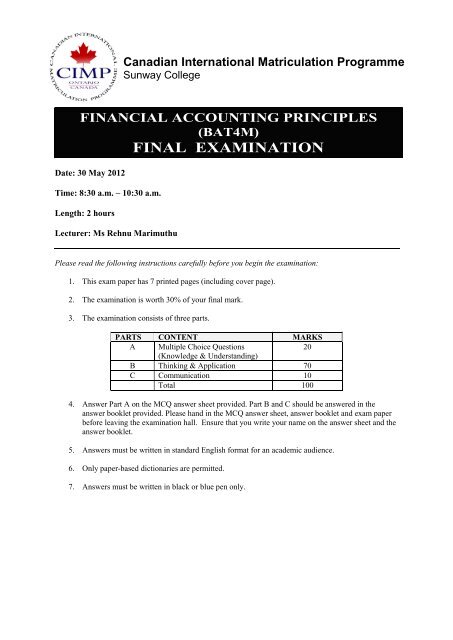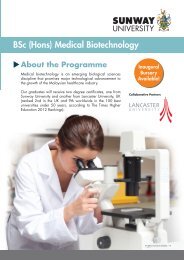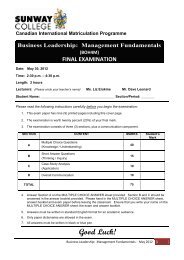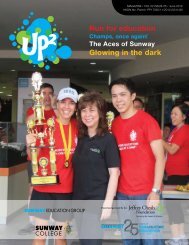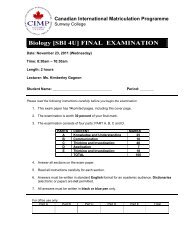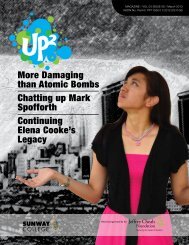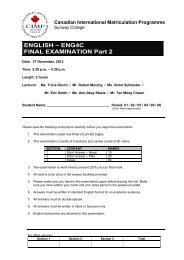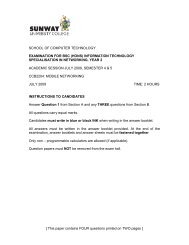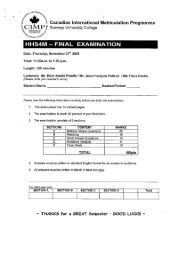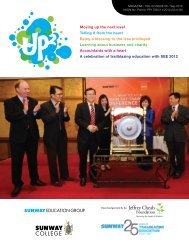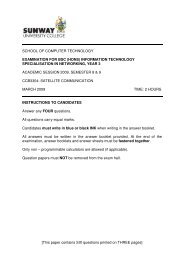Question Booklet - Sunway College
Question Booklet - Sunway College
Question Booklet - Sunway College
You also want an ePaper? Increase the reach of your titles
YUMPU automatically turns print PDFs into web optimized ePapers that Google loves.
Canadian International Matriculation Programme<br />
<strong>Sunway</strong> <strong>College</strong><br />
FINANCIAL ACCOUNTING PRINCIPLES<br />
(BAT4M)<br />
FINAL EXAMINATION<br />
Date: 30 May 2012<br />
Time: 8:30 a.m. – 10:30 a.m.<br />
Length: 2 hours<br />
Lecturer: Ms Rehnu Marimuthu<br />
Please read the following instructions carefully before you begin the examination:<br />
1. This exam paper has 7 printed pages (including cover page).<br />
2. The examination is worth 30% of your final mark.<br />
3. The examination consists of three parts.<br />
PARTS CONTENT MARKS<br />
A Multiple Choice <strong>Question</strong>s<br />
20<br />
(Knowledge & Understanding)<br />
B Thinking & Application 70<br />
C Communication 10<br />
Total 100<br />
4. Answer Part A on the MCQ answer sheet provided. Part B and C should be answered in the<br />
answer booklet provided. Please hand in the MCQ answer sheet, answer booklet and exam paper<br />
before leaving the examination hall. Ensure that you write your name on the answer sheet and the<br />
answer booklet.<br />
5. Answers must be written in standard English format for an academic audience.<br />
6. Only paper-based dictionaries are permitted.<br />
7. Answers must be written in black or blue pen only.
PART A: MULTIPLE CHOICE QUESTIONS (K/U)<br />
-----------------------------------<br />
Please shade the correct answer on the answer sheet provided.<br />
(20 Marks)
-----Page 4<br />
PART B: THINKING & APPLICATION<br />
-----------------------------------<br />
<strong>Question</strong> 1<br />
Richie operates Richie Rich Company. The trial balance of Richie Rich Company has the<br />
following accounts at its year-end, December 31, 2009:<br />
($)<br />
Accounts Payable 46,660<br />
Accounts Receivable 32,350<br />
Accumulated Depreciation – Building 25,340<br />
Accumulated Depreciation – Office Equipment 15,400<br />
Advertising Expense 15,930<br />
Allowance for Doubtful Accounts 1,294<br />
Bad Debts Expense 944<br />
Bank 25,500<br />
Building 102,640<br />
Depreciation Expense – Building 1,740<br />
Depreciation Expense – Office Equipment 4,400<br />
Insurance Expense 5,700<br />
Interest Expense 5,880<br />
Interest Revenue 7,056<br />
Merchandise Inventory 17,100<br />
Office Equipment 71,640<br />
Purchases 428,820<br />
Purchase Discounts 15,700<br />
Purchase Returns and Allowances 12,300<br />
Richie, Capital 113,000<br />
Richie, Drawings 9,000<br />
Salaries Expense 43,200<br />
Salaries Payable 1,840<br />
Sales 542,194<br />
Sales Discounts 2,500<br />
Sales Returns and Allowances 7,190<br />
Utilities Expense 6,250<br />
Other additional information:<br />
1. Merchandise inventory on December 31, 2009, is $22,220.<br />
2. Salaries expense is 50% selling and 50% administrative.<br />
3. Insurance expense is 60% selling and 40% administrative.<br />
4. Depreciation on building, depreciation on office equipment and utilities expense are<br />
administrative expenses.<br />
5. Advertising expense is a selling expense.<br />
6. Richie Rich Company uses a periodic inventory system.<br />
Instructions:<br />
a) Prepare the multiple-step income statement for the year ended 31 December 2009.<br />
(30 marks)
-----Page 5<br />
<strong>Question</strong> 2<br />
The balance sheet of Cluster Company shown below does not balance.<br />
CLUSTER COMPANY<br />
Balance Sheet as at December 31, 2010<br />
Assets<br />
Cash 6,700<br />
Accounts Receivable 400<br />
Supplies 1,200<br />
Unearned Revenue 3,018<br />
Equipment 15,000<br />
26,318<br />
Liabilities<br />
Accounts Payable 1,510<br />
Owner’s Equity<br />
Cluster, Capital 18,390<br />
19,900<br />
Each of the listed accounts has a normal balance per the general ledger. An examination of<br />
the ledger and journal reveals the following errors:<br />
1. A cash purchase of equipment for $693 was posted as a debit to Equipment for $693<br />
and credit to Accounts Payable for $639.<br />
2. A cash purchase of supplies for $700 was journalised and posted as a debit to<br />
Supplies for $70 and a credit to Cash for $70.<br />
3. A debit posting for salaries for $900 was made twice.<br />
4. A debit posting to accounts receivable for $500 was omitted.<br />
5. A payment to accounts payable for $491 was credited to Cash for $491 and debited to<br />
Accounts Receivable for $419.<br />
6. The withdrawal of $110 cash for Cluster’s personal use was debited to Office<br />
Expense for $110 and credited to Cash $110.<br />
Instructions:<br />
a) Prepare a correct balance sheet.<br />
(23 marks)
-----Page 6<br />
<strong>Question</strong> 3<br />
Muffin Ltd had a beginning inventory of 200 units at a cost of $12 per unit on 1 August.<br />
During the month, the following purchases and sales were made.<br />
Purchases<br />
Sales<br />
August 4 250 units at $13 August 7 150 units<br />
August 15 350 units at $15 August 11 100 units<br />
August 28 200 units at $14 August 17 300 units<br />
August 24 200 units<br />
Muffin Ltd uses a periodic inventory system.<br />
Instructions:<br />
a) Determine ending inventory and cost of goods sold under (i) average cost, (ii) FIFO,<br />
and (iii) LIFO.<br />
(17 marks)<br />
PART C: COMMUNICATION<br />
-----------------------------------<br />
(10 marks)<br />
1) What is the difference between accrued revenues and unearned revenues? (2 marks)<br />
2) A classmate is considering dropping his accounting class because he cannot<br />
understand the rules of debits and credits. In your opinion, can the student be<br />
successful in the course without an understanding of the rules of debits and credits?<br />
(4 marks)<br />
3) FIFO and LIFO are two different costing methods. Both methods report cost of goods<br />
sold, ending inventory, net income and income tax expense differently in the period of<br />
inflation. Explain the differences of both methods.<br />
(4 marks)


